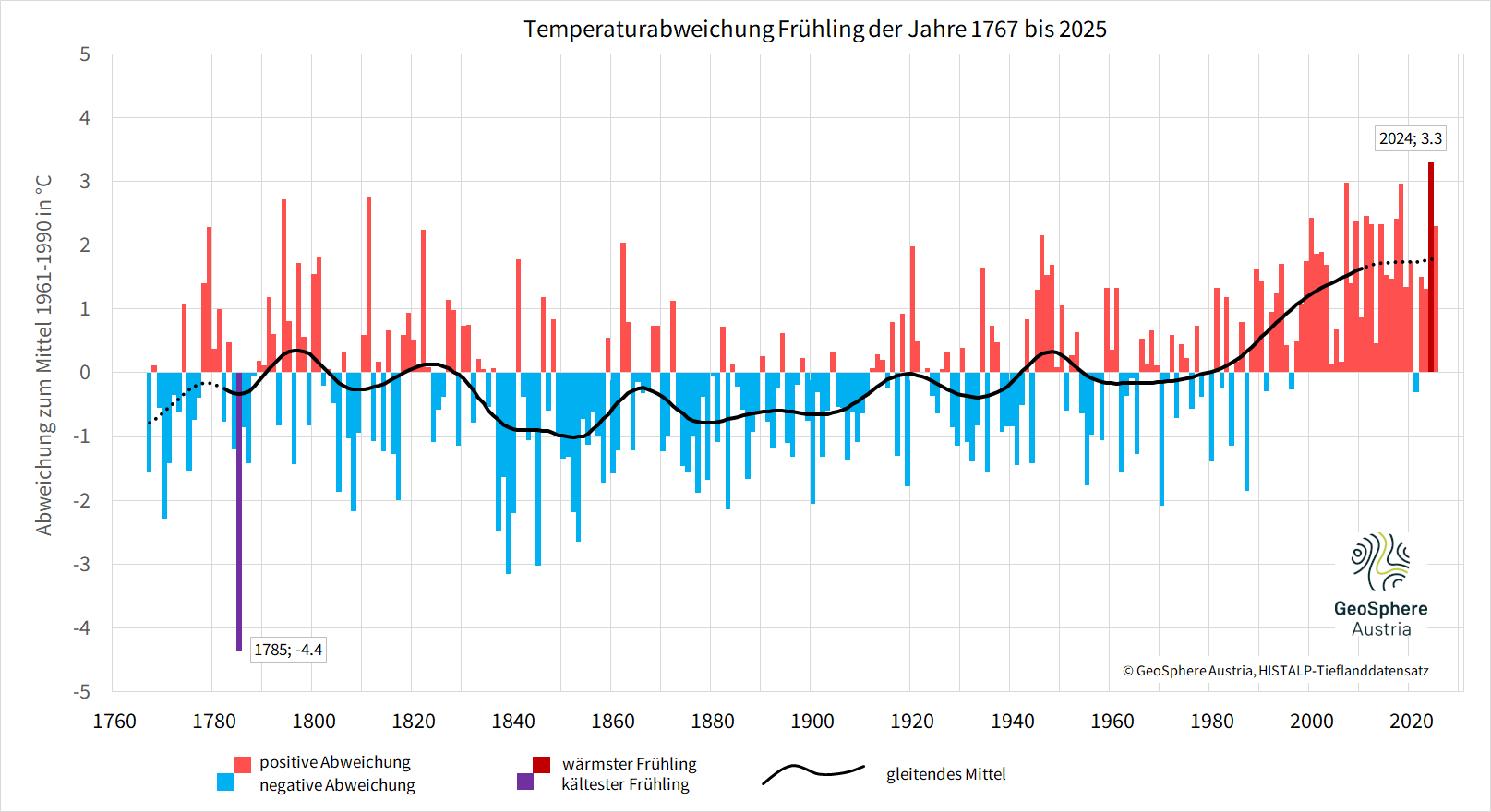Very mild spring with a cool end
GeoSphere Austria's preliminary climate assessment for spring 2025: 12th place in Austria's lowlands among the warmest springs in recorded history, 6th place in the mountains.
Even if the cool May suggests otherwise: The meteorological spring of 2025 turns out to be warmer than average.
‘In the preliminary evaluation, spring 2025 is 0.9 degrees above the average for the 1991 to 2020 climate period in Austria's lowlands and 1.1 degrees above the average in the mountains,’ says climatologist Alexander Orlik from GeoSphere Austria, ‘which puts Austria's lowlands in 12th place in the series of the warmest springs in the 259-year measurement history and the mountains in 6th place in the 175-year mountain measurement series.’
Compared to the 1961-1990 climate period, which was not yet so strongly influenced by global warming, the meteorological spring of 2025 was 2.3 degrees above average in the lowlands and 2.6 degrees above average in the mountains.
The extremely mild March and April are responsible for the high deviations. It was one of the fifteen warmest March months in recorded history and one of the ten warmest April months.
May, on the other hand, was relatively cool. In the preliminary evaluation, it is around 1.0 degree too cool compared to an average May in the recent past (climate period 1991 to 2020).
In a May around 50 years ago, temperatures like this year would still have been normal. This is because May 2025 is within the range of an average May in the period 1961 to 1990.
An analysis of the 21st century shows how rare relatively cool months have become in recent years: ‘In the 305 months since the year 2000, there have only been 73 months that were as cool or colder than the respective average as May 2025. That is only around 25 per cent of the months since the year 2000,’ says climatologist Orlik.
Due to the mild weather in March and April, this spring brought relatively little late frost: below 500 metres above sea level, there were an average of 13 frost days in Austria in the meteorological spring of 2025 (18 percent less than the 1991-2020 climate mean), from 500 to 1000 metres above sea level there were an average of 17 frost days (30 percent less than the climate mean) and from 1000 to 1500 metres above sea level there were an average of 24 frost days (35 percent less than the climate mean).
The cool May is mainly responsible for the low number of summer days (days with at least 25 °C): below 500 metres above sea level, there were an average of six summer days in Austria in spring 2025, and at altitudes of 500 to 1000 metres above sea level there were an average of three summer days. This is 25 per cent less than the climate average of the recent past (climate period 1991-2020).
Across Austria as a whole, the amount of precipitation in the meteorological spring of 2025 was pretty much in line with the long-term average (+3 per cent).
The regional analysis shows 10 to 30 per cent more precipitation than the average for the area from East Tyrol to Carinthia and Burgenland, in some cases up to 50 per cent.
It was relatively dry for the most part in the west and north of Austria and in places in the Vienna area, with deviations of -10 to -40 per cent from the long-term average. The relatively driest regions were Vorarlberg, Außerfern, Flachgau and Innviertel with 25 to 50 per cent less precipitation than the long-term average.
The first harbingers of spring, such as snowdrops (23 February 2025), hazel (21 February 2025) and willow (8 March 2025), bloomed on average across Austria in the range of the long-term average for the 1991 to 2020 climate period (snowdrop +3 days, hazel +1 day, willow -3 days). Compared to the period 1961 to 1990, the snowdrop bloomed one day earlier, the hazel eight days earlier and the willow twelve days earlier.
The very mild weather in March and April accelerated the development of nature. For example, lilacs (16 April 2025) bloomed five days earlier and horse chestnuts (16 April 2025) eight days earlier than in the period 1991 to 2020 and 14 and 16 days earlier than in the period 1961 to 1990.
The cool May dampened nature's development somewhat, but nature's head start is now already considerable. Early summer has already begun with the start of flowering of the black elderberry. The start of flowering of the black elderberry (4 May 2025) was on average eight days earlier than the long-term average over Austria in the period 1991 to 2020 and 19 days earlier than the long-term average in the period 1961 to 1990.
Translated with DeepL.com (free version)

